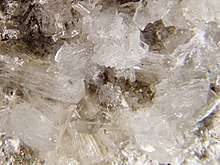Scawtite
Scawtite is a hydrous calcium silicate mineral with carbonate, formula: Ca7(Si3O9)2CO3·2H2O. It crystallizes in the monoclinic crystal system as thin plates or flat prisms.[2]
| Scawtite | |
|---|---|
 | |
| General | |
| Category | Silicate mineral |
| Formula (repeating unit) | Ca7(Si3O9)2CO3·2H2O |
| Strunz classification | 9.CK.15 |
| Dana classification | 64.2.1.1 |
| Crystal system | Monoclinic |
| Crystal class | Prismatic (2/m) (same H-M symbol) |
| Space group | C2/m |
| Unit cell | a = 10.12 Å, b = 15.18 Å c = 6.62 Å; β = 100.55°; Z = 2 |
| Identification | |
| Color | Colorless |
| Crystal habit | Platy - micaceous, parallel to radiating clusters |
| Cleavage | Perfect on {001}, poor on {010} |
| Mohs scale hardness | 4–5 |
| Luster | Vitreous |
| Diaphaneity | Transparent |
| Specific gravity | 2.77 |
| Optical properties | Biaxial (+) |
| Refractive index | nα = 1.597 - 1.603 nβ = 1.606 - 1.609 nγ = 1.618 - 1.621 |
| Birefringence | δ = 0.021 |
| 2V angle | Measured from 74° to 78° |
| References | [1][2][3] |
Scawtite was first described in 1929 for an occurrence at Scawt Hill in Northern Ireland.[2]
Scawtite occurs as in skarns and hydrothermal veins in limestone. Associated minerals include melilite, spurrite, tobermorite, thomsonite, larnite, grossular, bultfonteinite, calcite, analcime, foshagite and hillebrandite.[1]
References
This article is issued from Wikipedia. The text is licensed under Creative Commons - Attribution - Sharealike. Additional terms may apply for the media files.